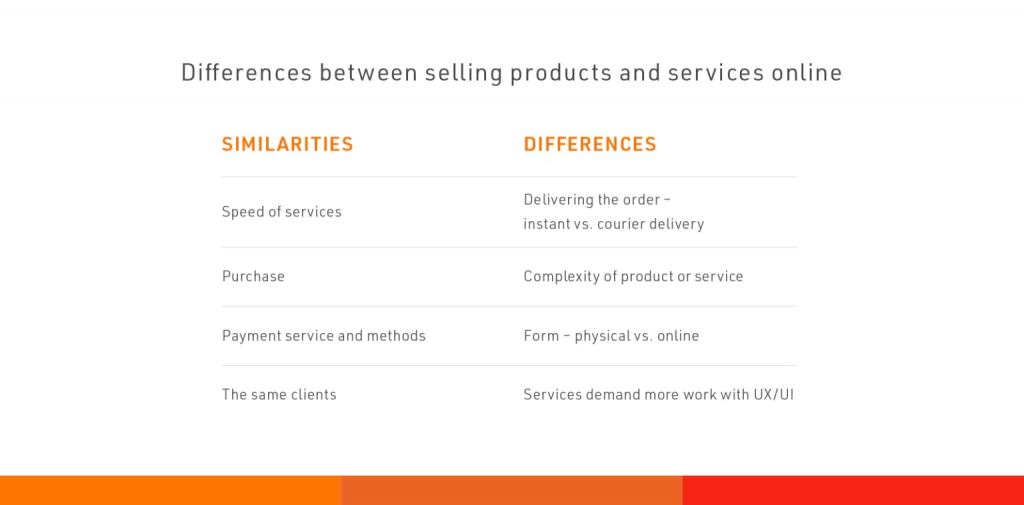4 Differences Between Selling Online Services and Classic Retail E‑Commerce
The service industry is going with trends and is in the midst of a transformation. The new sales model has forced a redefinition of the concept of e-commerce. Today, this category covers online commerce in not only goods but also services. However, there are still significant differences between these systems, forcing businesses to use a different approach. We have identified four key elements that define various ways of presenting and selling products and services online.
The world is changing – everything is becoming a service
E-commerce today is not only about selling products, but selling services as well. Many companies have decided that selling services online alongside the traditional path is a better business solution.
Currently, most day-to-day services are available on demand. Starting with television and telecommunication services, through streaming platforms for TV series, movies and music; or, for example, carshare rentals. The self-service model also covers sales in the insurance, tourism and financial industries (such as currency exchanges). For people accustomed to high-tempo e-commerce shopping, the expected model of shopping for services is also a self- service solution, whether in the form of a portal or a web application.
For companies just getting started with investing in offering services online, the differences in methods of selling them compared to traditional e-commerce are crucial to understand. Let’s look at what you should pay attention to and what’s important for our business during this kind of transformation.

Price
In the retail industry, the price of a product depends on the unit rate and the number of items bought. This value, after applying current promotions, makes it simple for us to calculate the final price. The customer buys the goods and pays once. Everything has its predetermined value. The situation is different for services, where the price depends on many additional factors, including:
- duration of use of the service
- time-limited promotions
- frequency of use of the service
- access to larger packages and potential to enhance them
- additional services
Availability
The challenge in setting the price of an internet service is not the only difference from classic retail e-commerce. The availability of services resulting from customer-side infrastructure restrictions may also be a problem – for example, a telecom must check if a cable hookup is available at the address indicated. Not every household has the option of using every Internet speed package.
Offer complexity
Another difference is the presentation of complex offers, which in the case of services sold via the internet are often broken down into many smaller variants and packages. At any given time, retail e-commerce presents primarily one product that the customer clearly sees on the product sheet – it has all the information, photos and graphics on it. This isn’t as obvious when it comes to online services. All of the benefits and capabilities must be presented to the client in an accurate and understandable way, because websites typically present what is often a legally binding offer. That is why awareness of good UX practices and their application is so important. This should apply to usability testing, the proper design of individual screens, and the purchase path. Legal requirements translate into the requirement to versioning of a website’s versions. For example, a bank must be able to present the version of the offer that was communicated on its website on a given day.
Backend challenges
Effective presentation of the offer requires such things as integration with a number of outside systems. This is another critical difference compared to retail e-commerce, which is classically integrated mainly with ERP and a payment service. For services offered online, integration with additional systems should be ensured. These systems include:
- systems that check service availability in a given location
- systems for initiating the service at this location
- an invoicing system that will automatically calculate fees and generate a relevant document each month (as opposed to retail e-commerce, in which one order equals one invoice)
- service testing systems that, among other things, monitor the use of free trial periods and the restrictions associated with each package
There can be a significant number of such systems, and without their proper integration the provision of related services becomes problematic. There may be errors in invoicing, payments, or even access to orders by consumers.
Summary
Despite many common features, from a technological point of view we can distinguish multiple key differences between retail e-commerce and e-commerce services that force a different approach to sales, tools, and systems used. Both services and retail attract the same customers who have a similar set of characteristics, values, and habits. This means that the requirements that online service providers have to meet remain the same as for classic sales.







